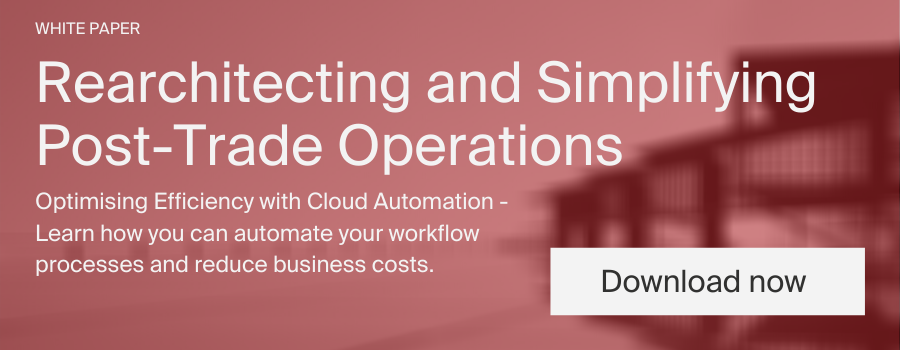
Rolling out new middle- and back-office technology should be a continuous process, but for some firms it’s more of a decennial event. The pace of change that has been set by regulators in recent years requires firms to fundamentally reassess their timescales and models for deployment. Going forward, fixed and widely-spaced schedules will prove to be problematic.
Working with software-as-a-service (SaaS) providers allows firms to take advantage of continuous delivery; 47% of SaaS providers use continuous delivery across all developments, compared to 28% of other firms. This is particularly important for the back office, where reliability, not reactivity, is key. But since reliability can only be determined over time, design and strategy flaws put in place today will only become apparent over the middle- to long-term, as clients review service levels.
The past few years have been a test of existing back-office operations. The level of data quality required to support external regulatory outputs (such as MiFID II transaction reports in Europe), as well as improved internal data governance requirements under the Comprehensive Capital Analysis and Review (CCAR) in the US, have far surpassed the levels of data infrastructure needed in the previous decade.
One option for smarter data management is to use a data lake. Centralised data lakes can help support new compliance objectives, client engagement, more granular risk management and tailored product development. But to do so, they have to be supported by the right back-office tools and development models to deliver those insights.
There are four key elements to making this smart deployment model work:
1. Move away from ‘fire-and-forget’ technology builds
To provide new services to clients while also managing demands from multiple stakeholders, it’s important to roll out new tools and evolve existing platforms through an ongoing, iterative delivery process of continuous integration and continuous deployment. Adopting this approach aligns the developers and users during the build, whereas the ‘fire-and-forget’ approach often means products are thrown over the fence to the user, with testing complete.
Testing is a continuous process, and it is the developers’ responsibility to produce as many automated tests as possible. Testing is needed to prove that new systems and functions:
- Have not damaged existing functionality, and;
- Have implemented the required functionality.
Fortune 1000 companies suffer costs of $500,000 to $1 million per hour due to application downtime, according to analyst firm IDC. Continuous integration and deployment allows a company to scale without being constrained by the testing schedule. Of course, you still need quality assurance to check elements that cannot be tested automatically.
2. Automate as much as you can
If a firm wants to move fast, testing needs to be an automated and integrated part of the development process. Continuous and transparent testing means that issues can be caught (and fixed) as early as possible, long before systems deployment. This saves everyone time, money, and stress.
Using the DevOps methodology
When employing DevOps, in which the developers of code also support it, automating things like integration testing allows the team members to focus on the production and release of the system. If firms implement a development methodology that enables continuous improvement and development, they can realise a 40% improvement in new business growth, according to a 2016 piece of research by business research firm Coleman Parkes.
When you can learn how to use a new platform from the people who actually built the platform, you have a better understanding of how the platform works. This means your whole team is better equipped to find and fix issues before they turn into problems. They can determine the differences between minor and major issues, and troubleshoot as needed to increase a platform’s uptime.
3. Align deployment strategies
There are always challenges when integrating new approaches into existing businesses. The new approaches need to align with the organisation receiving the technology. As a result, if vendors are to efficiently support a bank’s back office, they need to address the end-to-end process.
Banks need to be ready to support the model, working at the pace of the supplier, whether that is an internal or external function. There may need to be education early in the process, such as when the bank engages with a vendor.
4. Deploy in the cloud
Developing and testing in the cloud makes it easier to build environments to use immediately. It also makes it easier to shut those environments down, if needed, without bearing an ongoing cost. The cloud allows you to scale processes to whatever size a firm needs without fixed or manual set up costs. In the traditional model, with a data centre, it would take three months just to requisition the equipment. In the cloud, you can create a full test environment on demand, with just a few clicks.
In summary: when vendors can continually improve their systems, they can revolutionise the back office for their banking and broking clients. Our own integration of several systems into a single platform – Inferno – mirrors the goal we see clients trying to achieve. Speed, reliability and design of systems are substantially improved without increasing the cost of ownership. Deployment of the technology as a service enhances this approach further, with minimal impact for onsite technology teams, and a balanced upgrading of technology across the enterprise.
Firms receiving piecemeal patches and upgrades will soon find their service levels degrading when set against their peers, and while that may not be pointed out until an annual review, clients will be living with the consequences all year.
About Torstone Technology
Torstone is a leading global provider of cross-asset securities and derivatives post-trade processing technology. Torstone’s modern, award-winning Inferno platform is fast, flexible and future-proof. It enables global financial firms to reduce their costs, achieve greater control, minimise risk, and drive operational efficiency. Combining many decades of investment banking expertise with in-depth global financial market and technology industry knowledge, Torstone offers agile, secure, scalable, and cost-effective solutions.





